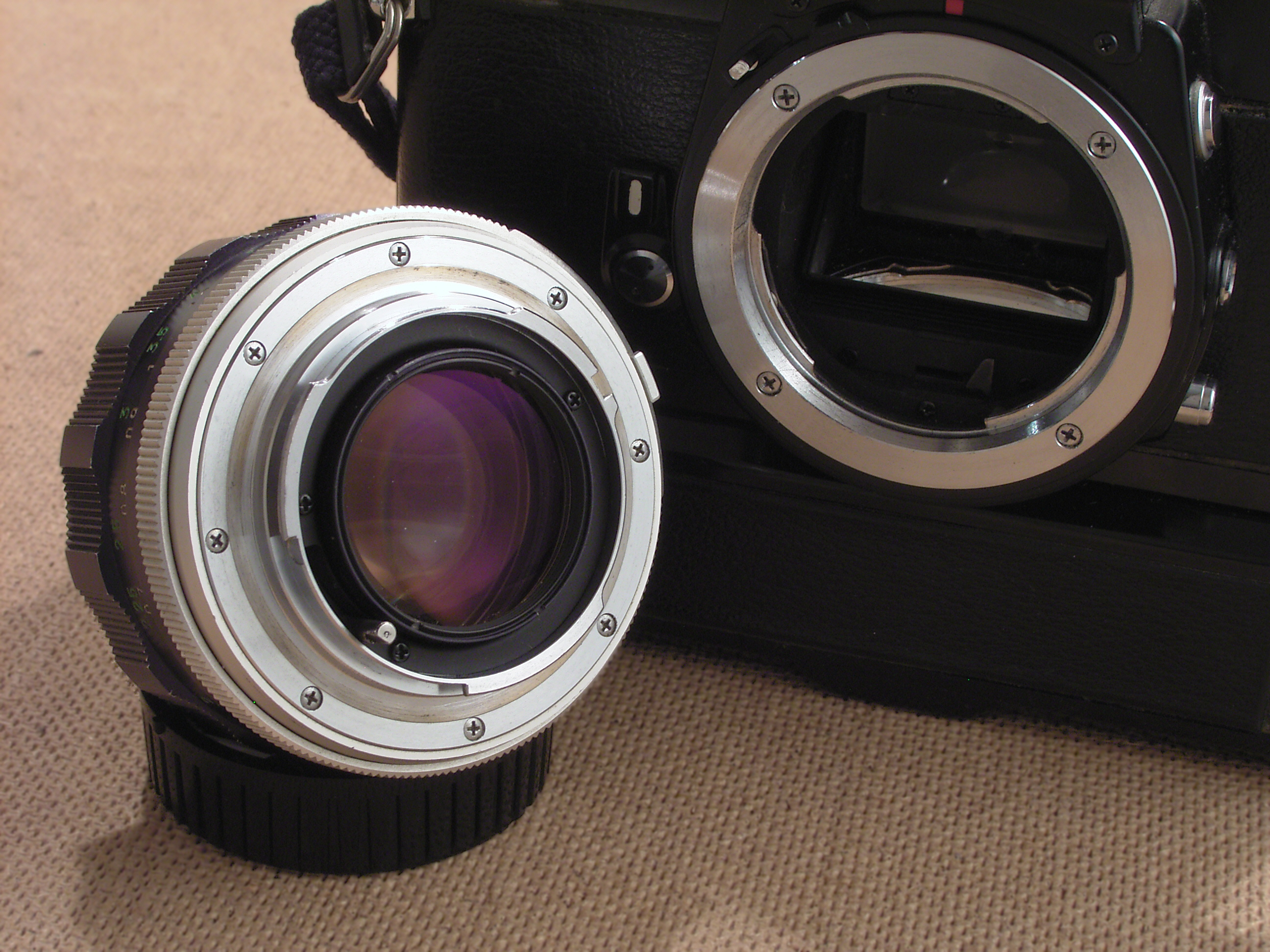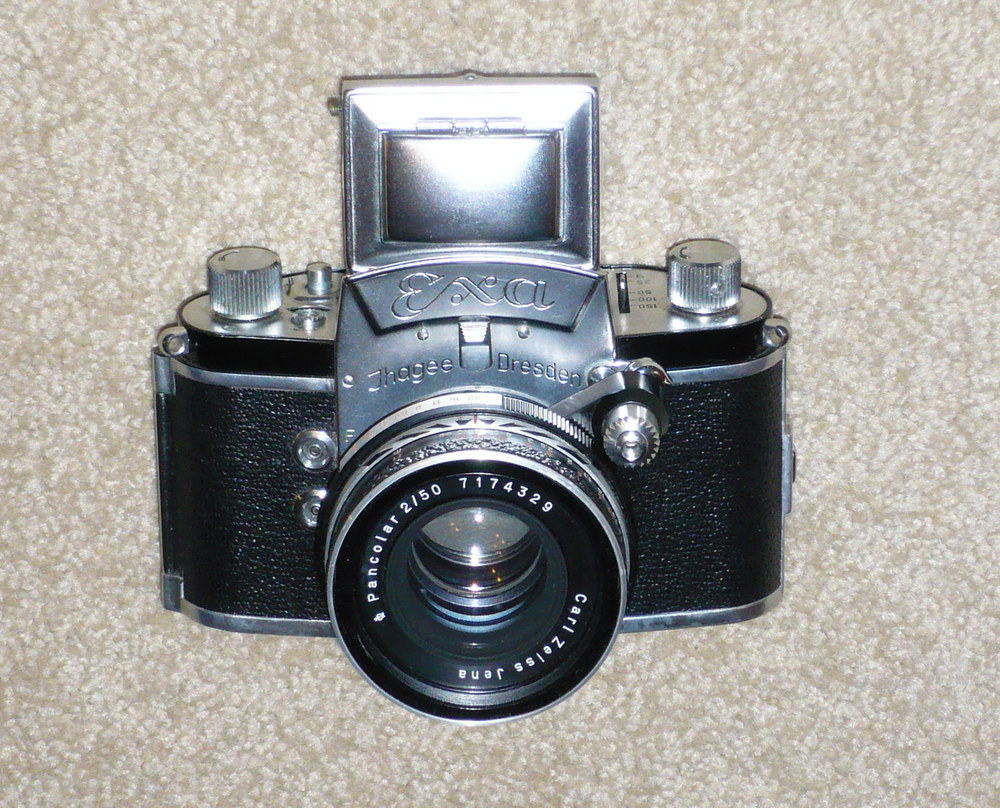|
Freelensing
Freelensing is a photography technique used with interchangeable lens cameras in both film-based and digital photography. The lens is detached from the camera and held in front of the lens mount by hand during exposure. This allows the lens to be tilted or shifted creating a similar effect to a perspective control or "Tilt-Shift" lens, only with a lower degree of fidelity. The result is a combination of selective focus and light leakage which are used creatively to create surreal imagery. Because of the increase in flange focal distance, this technique is most successful with closeup or macro photography, where infinity focus is not essential. The lens used does not necessarily have to be native to the brand of camera, since it is not physically attached to it. In addition, the lens may also be reversed for macro photography. By shooting through a normal to wide-angle lens backwards, increased magnification can be achieved. One of the by-products of freelensing is the introductio ... [...More Info...] [...Related Items...] OR: [Wikipedia] [Google] [Baidu] |
Lens Mount
A lens mount is an interface – mechanical and often also electrical – between a photographic camera body and a lens. It is a feature of camera systems where the System camera, body allows interchangeable lenses, most usually the rangefinder camera, single lens reflex type, single lens mirrorless type or any movie camera of 16 mm or higher film gauge, gauge. Lens mounts are also used to connect optical components in instrumentation that may not involve a camera, such as the modular components used in optical laboratory prototyping which join via C mount, C-mount or T-mount elements. Mount types A lens mount may be a screw-threaded type, a Bayonet#Linguistic impact, bayonet-type, or a breech-lock (friction lock) type. Modern still camera lens mounts are of the bayonet type, because the bayonet mechanism precisely aligns mechanical and electrical features between lens and body. Screw-threaded mounts are fragile and do not align the lens in a reliable rotational position, yet ... [...More Info...] [...Related Items...] OR: [Wikipedia] [Google] [Baidu] |
Flange Focal Distance
For an interchangeable lens camera, the flange focal distance (FFD) (also known as the flange-to-film distance, flange focal depth, flange back distance (FBD), flange focal length (FFL), back focus or register, depending on the usage and source) of a lens mount system is the distance from the mounting flange (the interlocking metal rings on the camera and the rear of the lens) to the film or image sensor plane. This value is different for different camera systems. The range of this distance, which will render an image clearly in focus within all focal lengths, is usually measured to a precision of hundredths of millimetres, and is not to be confused with depth of field. Lenses can be adapted from one mount (and respective FFD) to another. FFD determines whether infinity focus can be accomplished with a simple non-optical adapter. Optics to correct for distance introduce more cost and can lower image quality, so non-optical lens adapters are preferred. A simple non-optical adap ... [...More Info...] [...Related Items...] OR: [Wikipedia] [Google] [Baidu] |
Infinity Focus
In optics and photography, infinity focus is the state where a lens or other optical system forms an image of an object an infinite distance away. This corresponds to the point of focus for parallel rays. The image is formed at the focal point of the lens. In simple two lens systems such as a refractor telescope, the object at infinity forms an image at the focal point of the objective lens, which is subsequently magnified by the eyepiece. The magnification is equal to the focal length of the objective lens divided by the focal length of the eyepiece. In practice, not all photographic lenses are capable of achieving infinity focus by design. A lens used with an adapter for close-up focusing, for example, may not be able to focus to infinity. Failure of the human eye to achieve infinity focus is diagnosed as myopia. All optics are subject to manufacturing tolerances; even with perfect manufacture, optical trains experience thermal expansion. Focus mechanisms must accommodat ... [...More Info...] [...Related Items...] OR: [Wikipedia] [Google] [Baidu] |
A Snack
A, or a, is the first letter and the first vowel letter of the Latin alphabet, used in the modern English alphabet, and others worldwide. Its name in English is '' a'' (pronounced ), plural ''aes''. It is similar in shape to the Ancient Greek letter alpha, from which it derives. The uppercase version consists of the two slanting sides of a triangle, crossed in the middle by a horizontal bar. The lowercase version is often written in one of two forms: the double-storey and single-storey . The latter is commonly used in handwriting and fonts based on it, especially fonts intended to be read by children, and is also found in italic type. In English, '' a'' is the indefinite article, with the alternative form ''an''. Name In English, the name of the letter is the ''long A'' sound, pronounced . Its name in most other languages matches the letter's pronunciation in open syllables. History The earliest known ancestor of A is ''aleph''—the first letter of the Phoenician ... [...More Info...] [...Related Items...] OR: [Wikipedia] [Google] [Baidu] |
Macro Photography
Macro photography (or photomacrography or macrography, and sometimes macrophotography) is extreme close-up photography, usually of very small subjects and living organisms like insects, in which the size of the subject in the photograph is greater than life-size (though ''macrophotography'' also refers to the art of making very large photographs). By the original definition, a macro photograph is one in which the size of the subject on the negative or image sensor is life-size or greater. In some senses, however, it refers to a finished photograph of a subject that is greater than life-size. The ratio of the subject size on the film plane (or sensor plane) to the actual subject size is known as the reproduction ratio. Likewise, a macro lens is classically a lens capable of reproduction ratios of at least 1:1, although it often refers to any lens with a large reproduction ratio, despite rarely exceeding 1:1. Apart from technical photography and film-based processes, where th ... [...More Info...] [...Related Items...] OR: [Wikipedia] [Google] [Baidu] |
Holga
The Holga is a Medium format (film), medium format 120 film camera, made in Hong Kong, known for its Lo-fi photography, low-fidelity Aesthetics, aesthetic. The Holga's low-cost construction and simple meniscus lens often yields pictures that display vignetting, Focus (optics), blur, light leaks and other distortion (optics), distortions. The camera's limitations have brought it a cult following among some photographers, and Holga photos have won awards and competitions in fine art photography, art and photojournalism, news photography. As of July 2017, the camera is in production after being unavailable for two years. History The Holga camera was designed by Lee Ting-mo in 1982. It first appeared in 1982 in British Hong Kong. At the time, 120 film, 120 roll film in black-and-white was the most widely available film in neighbouring China. The Holga was intended to provide an inexpensive mass-market camera for the Chinese working class in order to record family portraits and event ... [...More Info...] [...Related Items...] OR: [Wikipedia] [Google] [Baidu] |
Diana (camera)
The Diana camera is a plastic-bodied toy camera that uses 120 film, 120 roll film and 135 film, 35 mm film. The camera has a simple plastic meniscus lens. Originally marketed as an inexpensive novelty gift item, the Diana has been used to take soft focus, Impressionism, impressionistic photographs somewhat reminiscent of the Pictorialist Period of artistic photography, branded in contemporary times as Lomography (company), Lomography. The Diana frequently suffers from light leaks, film advance issues, and other problems. However, its low-quality plastic lens has been celebrated for its artistic effects in photographs, normally resulting in a slightly blurred composition that can provide a 'dreamlike' quality to the print. History The Diana first appeared during the early 1960s as an inexpensive box camera sold by the ''Great Wall Plastic Factory'' of Kowloon, Hong Kong.Featherstone, p. 5 Most were exported to the United States and the United Kingdom. In the United States, the D ... [...More Info...] [...Related Items...] OR: [Wikipedia] [Google] [Baidu] |
Single-lens Reflex Camera
In photography, a single-lens reflex camera (SLR) is a type of camera that uses a mirror and prism system to allow photographers to view through the lens and see exactly what will be captured. SLRs became the dominant design for professional and consumer-level cameras throughout the late 20th century, offering interchangeable lenses, through-the-lens (TTL) metering, and precise framing. Originating in the 1930s and popularized in the 1960s and 70s, SLR technology played a crucial role in the evolution of modern photography. Although digital single-lens reflex (DSLR) cameras succeeded film-based models, the rise of Mirrorless camera, mirrorless cameras in the 2010s has led to a decline in SLR use and production. With twin lens reflex and rangefinder cameras, the viewed image could be significantly different from the final image. When the shutter button is pressed on most SLRs, the mirror flips out of the light path and allows light to pass through to the light receptor and the im ... [...More Info...] [...Related Items...] OR: [Wikipedia] [Google] [Baidu] |
Digital Single-lens Reflex Camera
A digital single-lens reflex camera (digital SLR or DSLR) is a digital camera that combines the optics and mechanisms of a single-lens reflex camera with a solid-state image sensor and digitally records the images from the sensor. The reflex design scheme is the primary difference between a DSLR and other digital cameras. In the reflex design, light travels through the lens and then to a mirror that alternates to send the image to either a prism, which shows the image in the optical viewfinder, or the image sensor when the shutter release button is pressed. The viewfinder of a DSLR presents an image that will not differ substantially from what is captured by the Image sensor, camera's sensor, as it presents it as a direct optical view through the main camera lens rather than showing an image through a separate secondary lens. DSLRs largely replaced film-based SLRs during the 2000s. Major camera manufacturers began to transition their product lines away from DSLR cameras to mirror ... [...More Info...] [...Related Items...] OR: [Wikipedia] [Google] [Baidu] |
Mirrorless Interchangeable-lens Camera
A mirrorless camera (sometimes referred to as a mirrorless interchangeable-lens camera (MILC) or digital single-lens mirrorless (DSLM)) is a digital camera which, in contrast to DSLRs, does not use a mirror in order to ensure that the image presented to the photographer through the viewfinder is identical to that taken by the camera. They have come to replace DSLRs, which have historically dominated interchangeable lens cameras. Other terms include electronic viewfinder interchangeable lens (EVIL) and compact system camera (CSC). When compared to similar DSLRs, these cameras can be smaller, lighter, and quieter. In cameras with mirrors, light from the lens is directed to either the image sensor or the viewfinder. This is done using a mechanical movable mirror which sits behind the lens. By contrast, in a mirrorless camera, the lens always shines light onto the image sensor, and what the camera sees is displayed on a screen for the photographer. Some mirrorless cameras also ... [...More Info...] [...Related Items...] OR: [Wikipedia] [Google] [Baidu] |





